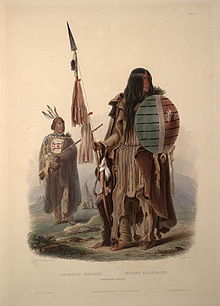
Back Асінібойн Byelorussian Assiniboines Catalan Hóheeheo'o CHY Assiniboine German Assiniboine Spanish Assiniboin Basque Assiniboinet Finnish Assiniboines French Assiniboin (folk) Frisian Assiniboin Indijanci Croatian
 Two Assiniboine warriors, painted by Karl Bodmer | |
| Total population | |
|---|---|
| 3,500[1] | |
| Regions with significant populations | |
| Canada (Manitoba, Saskatchewan and Alberta) United States (North Dakota and Montana) | |
| Languages | |
| Assiniboine, English | |
| Religion | |
| traditional tribal religion, Sun Dance, Native American Church, Christianity | |
| Related ethnic groups | |
| Dakota, Stoney[1] |
| Nakota / Nakoda / Nakona[2] "ally / friend" | |
|---|---|
| Person | Nakóda[3] |
| People | Nakón Oyáde[3] |
| Language | Nakón Iyábi[4] Nakón Wíyutabi[4] |
| Country | Nakón Mąkóce |
The Assiniboine or Assiniboin people (/əˈsɪnɪbɔɪn/ when singular, Assiniboines / Assiniboins /əˈsɪnɪbɔɪnz/ when plural; Ojibwe: Asiniibwaan, "stone Sioux"; also in plural Assiniboine or Assiniboin), also known as the Hohe and known by the endonym Nakota (or Nakoda or Nakona), are a First Nations/Native American people originally from the Northern Great Plains of North America.
Today, they are centred in present-day Saskatchewan. They have also populated parts of Alberta and southwestern Manitoba in Canada, and northern Montana and western North Dakota in the United States. They were well known throughout much of the late 18th and early 19th century, and were members of the Iron Confederacy with the Cree. Images of Assiniboine people were painted by 19th-century artists such as Karl Bodmer and George Catlin.
- ^ a b "Assiniboine." Ethnologue. Retrieved March 30, 2013.
- ^ For the usage of the term "Nakona" by Fort Peck's Assiniboine, cf. http://fpcctalkindian.nativeweb.org/ and http://www.neh.gov/grants/guidelines/hisamples/HI-TCU-FortPeck.pdf Archived 2011-06-15 at the Wayback Machine
- ^ a b "Assiniboine". AISRI Dictionary Database Search. American Indian Studies Research Institute. Retrieved December 30, 2023.
- ^ a b "Language". AISRI Dictionary Database Search. American Indian Studies Research Institute. Retrieved December 30, 2023.
© MMXXIII Rich X Search. We shall prevail. All rights reserved. Rich X Search